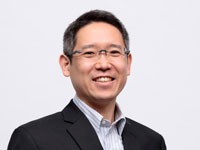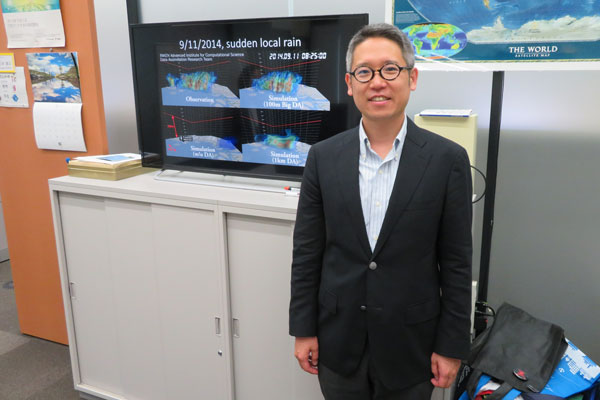Jun. 26, 2020
Minute-to-minute weather prediction
Takemasa Miyoshi, Team Leader

Data Assimilation Research Team, RIKEN Center for Computational Science
Explain how data assimilation contributes to predicting weather.
To simulate weather with great precision, we have to feed a prediction system with real data, such as temperature, atmospheric pressure and prior forecasts. That’s data assimilation. How observational data is assimilated significantly affects the accuracy of weather predictions, and it needs to be processed carefully. My research is about how to do this processing effectively, which is a challenge today because we have more and more data and it’s hard to incorporate all of them into our models.
How much will Supercomputer Fugaku improve the capability of your simulations?
The Fugaku will achieve a 100-fold improvement in application capability compared to RIKEN’s recently decommissioned, world-leading supercomputer, the K computer. If we can only do one simulation with the K computer, we will be able to run 100 simulations in parallel at the same time using Fugaku. In this way, we can measure a range of uncertainties.
You’ve helped improve predictions of torrential rainfall. How will that make people’s lives better?
Without our unique Big Data assimilation system, we essentially have no predictive power for small-scale, localized torrential rainfall. While we received new data every 30 seconds, our models sometimes rejected it because real-world data has noise and missing values. Now we can find out what might happen 30 minutes in the future. For disaster prevention, it could help decide when to evacuate or move things.

Obviously, you can’t use such advanced computers all the time. How are conventional weather forecasting computers advancing?
In Japan, the Japan Meteorological Agency operates their own supercomputer dedicated to weather prediction. And that computer has something like a tenth of the capability of the most powerful computer right now. That is still quite powerful. What we can do with the K computer or Fugaku is actually to explore what we will be able to do 10 years in the future, when meteorological agencies may have similarly powerful systems.
What is your dream as a researcher?
My dream is to develop a new fundamental theoretical framework with which to think about prediction in general. That’s a whole new field of science, but I’m ready to dig into that direction because of advances in big data and computation technologies.
Why did you choose RIKEN?
Simply stated, it was because of the K computer. I was a professor at the University of Maryland in the United States. I had great freedom to do what I wanted because academic freedom is very important at universities in the United States. I was very happy, but I wanted to do something ground-breaking.
